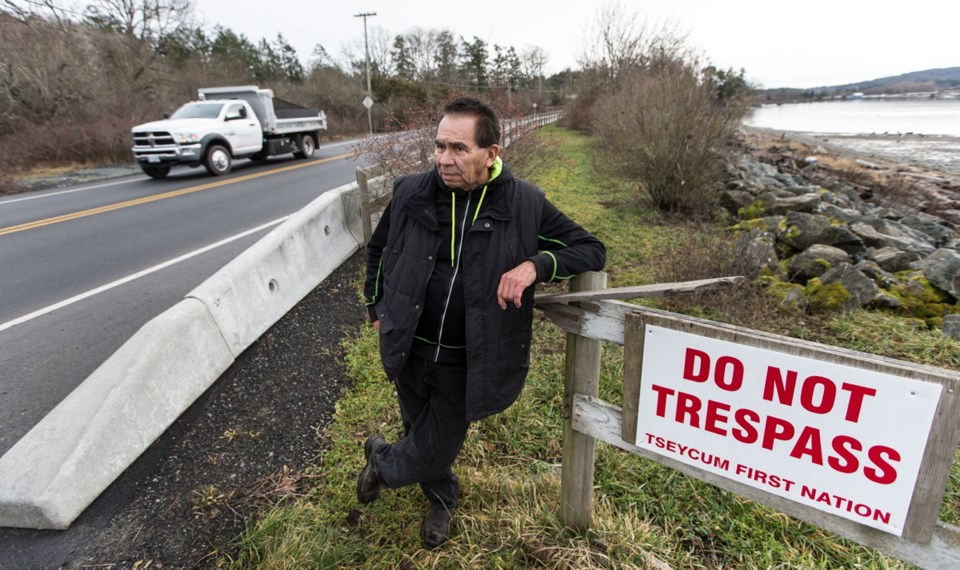Vern Jacks looks out his kitchen window at a road that he says has divided his community for more than a century.
“That road was never supposed to be here. As long as I’m alive I will keep saying that,” said Jacks, 72, an elder and former chief of the Tseycum First Nation on West Saanich Road. The road is a major traffic route on the Saanich Peninsula that goes through the residential reserve, separating it from the waterfront.
Jacks is upset over recent upgrades that widened and resurfaced a 500-metre section of the road over an ancestral gravesite. He wants the chief and council to lobby the province to move the road and permanently protect the gravesite. “This is about protecting our people, our ancestors,” Jacks said.
Tseycum Chief Tanya Jimmy said the road upgrade was done after years of consultation with the community and province.
The road was falling apart in places, putting the gravesite and lives at risk, she said. The upgrade included adding a crosswalk and bus stop pads on either side of the busy road as part of a $2.3-million reconciliation agreement.
“The road was really bad. There were numerous accidents,” said Jimmy, adding the crosswalk and shoulder make it safer for pedestrians. Tseycum has more than 150 members and many are children.
Jimmy said the idea of moving the road was brought up in the past, but ultimately rejected by the community because of the longhouse location — which members want to remain private. She said a new road has never been part of the community plan.
Jacks spread out on his kitchen table photos and articles from three decades of work.
“You can see the longhouses along the shore,” he said, looking at a 1917 photo showing the narrow, grassy beginnings of West Saanich Road in front of rows of longhouses on the waterfront.
“It started with a horse and buggy road but at least they went around the graves,” said Jacks, who believes the road was built in the late 1800s.
“The highway men came and asked our people if they could build the road and we said ‘No,’ ” he said. “They said it was going to go behind [the reserve] not along the water.”
Jacks said when the community left for annual food harvesting, the road was built without consent. Since then, the road has caused conflict and trauma — which he’s documented for years.
In 1928, the First Nation hired a lawyer and complained to the province the road was over a gravesite. In the 1950s and 1960s, community members described seeing bones on the side of the road when work was done — including two skulls displayed on the ends of shovels.
“In 1955, my grandmother stood in the road trying to stop the work, apologizing to our ancestors,” Jacks said.
In the 1970s, wind and erosion led to bones being swept away and large rocks added to the shoreline. In 1994, Jacks threatened to block West Saanich Road after frustration with speeders and racist graffiti. Around that time, Jacks was also in talks with the then-NDP government to look at moving the road.
“But then they lost the election,” he said.
When North Saanich put in a new sewer line in 2006, bones estimated to be between 1,000 and 1,500 years old were found under the road. The district went around the site.
In 2009, Jacks pushed the provincial government for compensation for the road being built — threatening to tear up West Saanich road to re-bury further remains.
“Human beings that used to walk the earth are under that road,” Jacks said. “Under the Douglas Treaties, gravesites were to be protected and it’s not happening.”
Jacks is referring to treaties signed by Governor Sir James Douglas in the mid-1800s that recognized First Nations rights to village sites and enclosed fields, such as gravesites, he said. In Canada, aboriginal burial grounds have a different status from cemeteries built after colonization and much fewer protections.
“We need to sit down with the province and change the legislation to protect our ancestors,” said Jacks. He was integral in advocating for proper treatment of ancestral remains found at the building site of Poets Cove resort on Pender Island in 2005, the repatriation of bones stolen from Tseycum that ended up in the New York Museum of Natural History in 2006 and the protection of an ancient grave site at Salt Spring Island’s Grace Islet in 2014 when a mansion was set to be built over it.
Indigenous scholars say government and infrastructure decisions have a long history of causing conflict for First Nations communities and could continue to do so if land rights are not resolved.
“This is common across Canada,” said Taiaiake Alfred, indigenous governance professor at the University of Victoria. “Racism towards Indigenous peoples, their land rights and sacred spaces dismissed, made them an easy target for putting roads wherever.”



